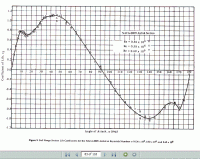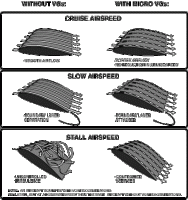You might regret getting me started on the subject of aerodynamics

To understand how VG's work you need to think about how the boundary layer (that's the thin layer of air next to the wing surface) moves. In smooth laminar flow the boundary layer slides smoothly over the wing surface. When the plane flys slowly the air doesn't have much momentum so because the air is viscous, and there is drag as it moves over the wing surface, and also because it moves from low pressure on the front part of the wing to higher pressure near the TE, the boundary layer runs out of momentum, slows down and builds into a thick sluggish layer or may stop altogether in a static 'bubble' of stationary air, aka '
laminar separation bubble'. The faster moving air above the boundary layer is forced away from the wing surface by the thickening boundary layer and eventually 'breaks away' altogether.. i.e. the wing stalls.
Vortex generators work like tiny wings. They stick ip through the thin boundary layer near the leading edge and into the faster moving freestream air. They are set at a high angle of attack to the airflow and so form a vortex at their tips just like the tips of wings. This vortex in the fast moving freestream 'mixes' with the slow moving boundary layer and 'pulls' it along, preventing or delaying the boundary layer slowing or stopping, this delays separation and stall.
Sorry if I'm geeking out a bit

I did say you might regret getting me started....
One other thing to consider is that wings still make lots of lift after they stall. Many seem to think that when a wing stalls all the lift goes away but that's just not the case. A typical wing might stall at maybe 10-15 degrees and the lift will fall by maybe 20%, but if you keep increasing the angle of attack then the lift will start to increase again. By the time the wing reaches 25 or 30 degrees then it's making as much lift as it did just before it stalled. By the time it gets to around 45 degees then it will be making significantly more lift than it ever did before stalling, before it decreases again as you go past 45 degrees.
So why do planes fall out of the sky when they stall and why dont normal planes fly at 45 degrees angle of attack...? Drag is the answer. When a wing stalls drag increases enormously, so the plane slows down. Slowing down decreases lift and this coupled with the drop in lift immediately after stall sees the plane fall from the sky. Drag is also the reason most planes dont fly at 45 deg, most planes simply would not have the thrust needed to overcome the huge drag produced at that angle of attack.
Here's a graph showing lift through a full 180 deg airfoil rotation, note the peak lift occurs around 40- 45 deg AoA.

Steve


